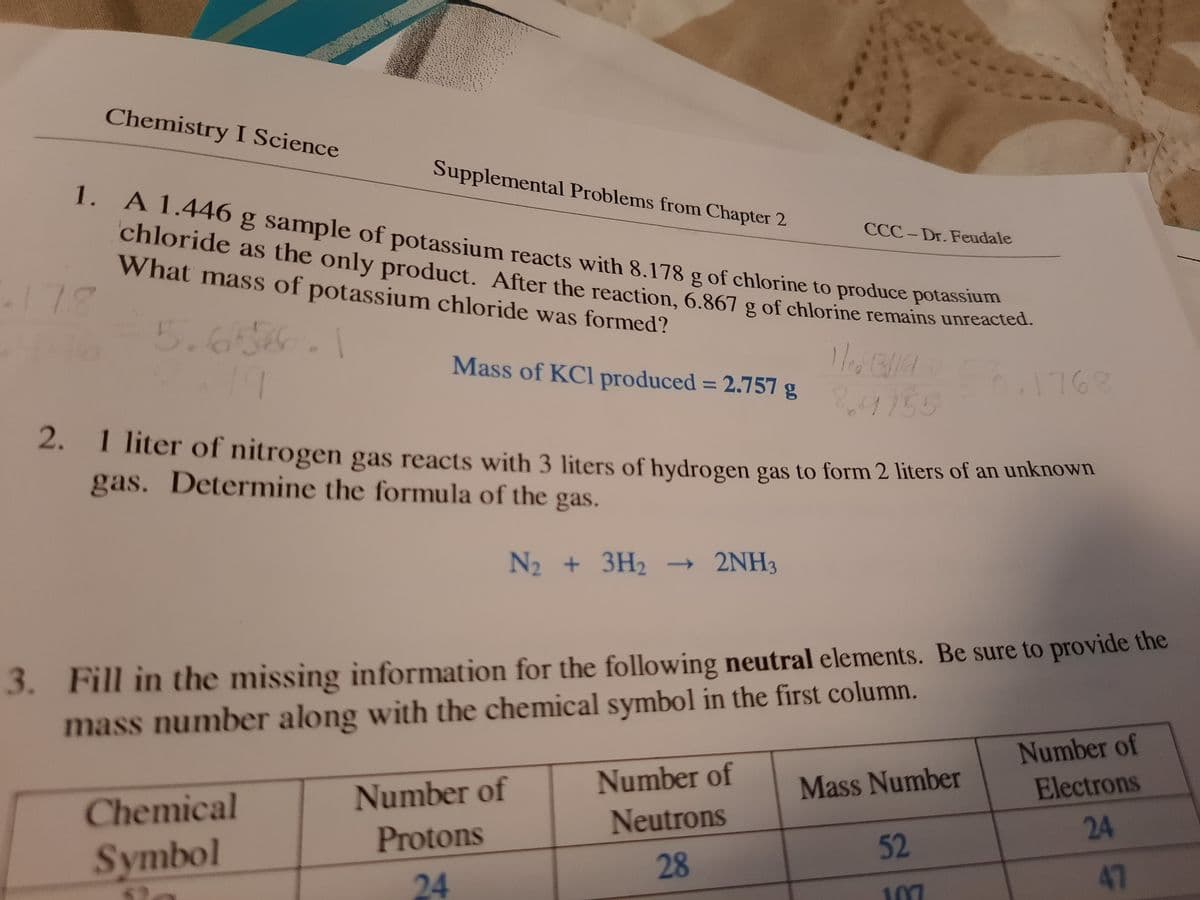157 g 2. I liter of nitrogen gas reacts with 3 liters of hydrogen gas to form 2 liters of an unknown gas. Determine the formula of the gas. N2 + 3H2 ΝΗ3
157 g 2. I liter of nitrogen gas reacts with 3 liters of hydrogen gas to form 2 liters of an unknown gas. Determine the formula of the gas. N2 + 3H2 ΝΗ3
Chemistry: Matter and Change
1st Edition
ISBN:9780078746376
Author:Dinah Zike, Laurel Dingrando, Nicholas Hainen, Cheryl Wistrom
Publisher:Dinah Zike, Laurel Dingrando, Nicholas Hainen, Cheryl Wistrom
Chapter3: Matter-properties And Changes
Section: Chapter Questions
Problem 9STP
Related questions
Question
100%
For number 2, how do we know N2 and H2 are games? Is the 2 subscription after them how we express all elements as games?

Transcribed Image Text:'chloride as the only product. After the reaction, 6.867 g of chlorine remains unreacted.
Chemistry I Science
Supplemental Problems from Chapter 2
1. A1.446 g sample of potassium reacts with 8.178 g of chlorine to produce potassium
CCC – Dr. Feudale
chloride as the only product. After the reaction, 6.867 g of chlorine remains unreacted.
What mass of potassium chloride was formed?
.178
5.65
Mass of KCl produced = 2.757 g
0.1768
2.
. 1 liter of nitrogen gas reacts with 3 liters of hydrogen gas to form 2 liters of an unknown
gas. Determine the formula of the gas.
N2 + 3H2
→ 2NH3
3. Fill in the missing information for the following neutral elements. Be sure to provide the
mass number along with the chemical symbol in the first column.
Number of
Electrons
Number of
Mass Number
Number of
Chemical
Neutrons
Protons
24
52
Symbol
28
24
47
107
Expert Solution
This question has been solved!
Explore an expertly crafted, step-by-step solution for a thorough understanding of key concepts.
This is a popular solution!
Trending now
This is a popular solution!
Step by step
Solved in 4 steps

Knowledge Booster
Learn more about
Need a deep-dive on the concept behind this application? Look no further. Learn more about this topic, chemistry and related others by exploring similar questions and additional content below.Recommended textbooks for you

Chemistry: Matter and Change
Chemistry
ISBN:
9780078746376
Author:
Dinah Zike, Laurel Dingrando, Nicholas Hainen, Cheryl Wistrom
Publisher:
Glencoe/McGraw-Hill School Pub Co


Introductory Chemistry: A Foundation
Chemistry
ISBN:
9781337399425
Author:
Steven S. Zumdahl, Donald J. DeCoste
Publisher:
Cengage Learning

Chemistry: Matter and Change
Chemistry
ISBN:
9780078746376
Author:
Dinah Zike, Laurel Dingrando, Nicholas Hainen, Cheryl Wistrom
Publisher:
Glencoe/McGraw-Hill School Pub Co


Introductory Chemistry: A Foundation
Chemistry
ISBN:
9781337399425
Author:
Steven S. Zumdahl, Donald J. DeCoste
Publisher:
Cengage Learning

Chemistry: Principles and Reactions
Chemistry
ISBN:
9781305079373
Author:
William L. Masterton, Cecile N. Hurley
Publisher:
Cengage Learning

Chemistry
Chemistry
ISBN:
9781305957404
Author:
Steven S. Zumdahl, Susan A. Zumdahl, Donald J. DeCoste
Publisher:
Cengage Learning
